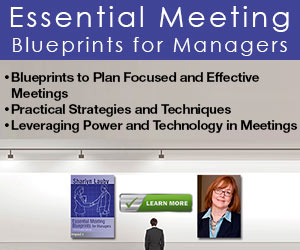Creating Strategy and Being Strategic Aren’t the Same Thing
(Editor’s Note: Today’s post is an excerpt from my book, “Essential Meeting Blueprints for Managers.” The book is available on Amazon in hard copy and Kindle, in the iTunes store, and directly from the publisher.”
Before we can talk about strategic planning, it’s important to discuss the difference between creating a strategy and being strategic. Just because someone can create a strategy doesn’t mean they can think strategically.
According to the Cambridge dictionary, strategy is a detailed plan for achieving results. There are many different kinds of business strategies – marketing strategies, compensation strategies, recruitment strategies, social media strategies, even strategic plans. You get the point.
Thinking strategically means a person is capable of a thought process that allows them to facilitate a dialogue of critical thinking and innovation. This isn’t to say that the two aren’t interrelated. Creating strategy is important for business. But strategic thinking is a competency that needs to be developed.
If you are interested in exploring the connection between these two concepts, Jeanne Liedtka penned a fascinating article on the five elements of strategic thinking titled “Linking Strategic Thinking with Strategic Planning” that really deserves a read. As business professionals, I wonder how much time and emphasis we are placing on these elements:
- Systems perspective (i.e. having the ability to see the entire picture).
- Intent-focused, which is being able to create a focus for employees to concentrate on the goal.
- Intelligent opportunism reminds us of the conversations happening about the opportunity economy and being open to new ideas that are good for business.
- Thinking in time refers to the view of referencing the past to create the future. And using the proper analogies to create linkages and anticipate trends.
- Lastly, being hypothesis-driven. Yes, the classic scientific theory rears its head. Being able to reason and test a hypothesis is key to effective strategic thinking.
For business professionals, this means relying less on gut instinct and more on analytics. We need to shift our focus from a “been there, done that, so I know the answer” to a “been there, know what happened, now let’s apply the learnings to our current situation.”
It’s easy to see the value in strategic thinking. Being able to effectively apply our theoretical knowledge and in-the-trenches experience will serve us well.
1